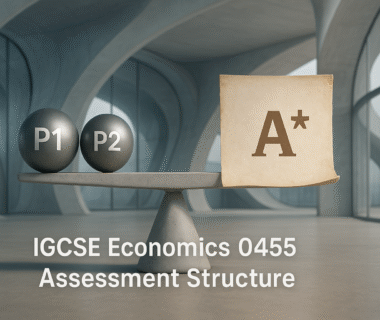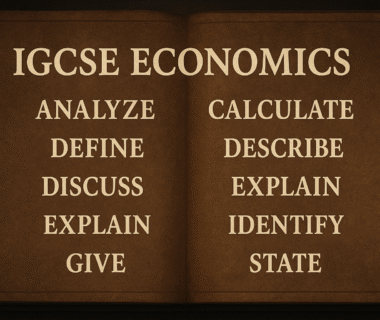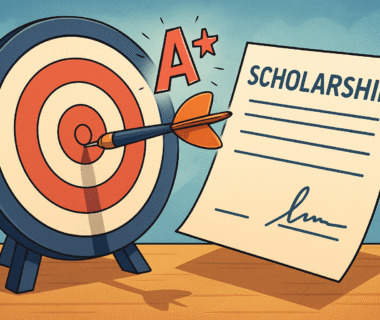We’ve talked a little bit about the syllabus and what IGCSE Economics 0455 consists of, as well as assessment objectives and a range of other things.
In case you haven’t gone into a total state of catatonia while you think about taking on this new subject just yet, then in that case, today, let’s dive deep into the IGCSE Economics 0455 Assessment structure so you’ll understand exactly how you will be assessed in the exams!
The Cambridge IGCSE Economics (0455) assessment is made up of two papers:
🧮 Paper 1: Multiple Choice
⏱ Time: 1 hour
📝 Marks: 40 marks
📊 Weight: 30% of the final grade
📦 Format: 40 multiple-choice questions
✅ What It Tests
- AO1: Knowledge and understanding
- AO2: Application and analysis
Expect to be tested on definitions, calculations, diagram interpretations, and quick conceptual relationships (e.g. shifts in supply/demand, price mechanisms).
🔎 Real-World Examples
- “What is the opportunity cost of a choice?”
- “If price increases from $5 to $6 and quantity falls from 100 to 80, what is the PED?”
- “Which diagram shows a contraction in demand?”
🧠 Pro Tips (Beyond the Syllabus)
- Don’t underestimate this paper. Many students treat MCQ as “easy marks,” but 4 deceptively plausible answers require deep understanding.
- Time yourself tightly — that’s 1.5 minutes per question. Don’t linger. Skip and return. Remember that every single question is worth the same number of points. If you get one wrong, it is bad, but you shouldn’t let any individual question take up your time to the point that you end up losing marks on the rest of the paper.
- Master your diagrams. Many questions show supply and demand graphs — a small shift can change the entire meaning. Understand what everything means, why it works that way, and how to use the diagrams in order to illustrate or understand real-world situations. Understanding the theory itself is something that you can brag about, but if you cannot deal with real-world situations, I doubt that you understand the theory.
- Memorize formulas cold — PED, PES, GDP per capita, average cost, etc. Make sure to know how to use them and practice using them with real questions.You won’t have time to figure them out on the spot.
- Use process of elimination. Even if you’re unsure of the right answer, you can usually spot at least one wrong one.
✍️ Paper 2: Structured Questions
⏱ Time: 2 hours
📝 Marks: 80 marks
📊 Weight: 70% of the final grade
📦 Format:
- Section A: 1 compulsory data response question (20 marks)
- Section B: 3 out of 4 extended response questions (3 × 20 marks)
✅ What It Tests
- All 3 Assessment Objectives:
- AO1: Knowledge
- AO2: Application and Analysis
- AO3: Evaluation
🔍 Section A – Data Response
You’re given a short article, chart, graph, or table and a set of questions from (a) to (f).
This is where Cambridge tests your ability to:
- Read real-world economic data
- Extract and apply relevant concepts
- Use evidence to support answers
- Demonstrate analysis and some evaluation
✅ Insider Insight:
- This section reflects what the examiners consider a “real economist in action.”
- You MUST use the data provided – don’t ignore it. Quote a figure, mention a trend, refer to the chart. USE your data.
- Common error: Writing answers as though this were a generic question. If they gave you a chart about Malaysia’s inflation, don’t answer as if it’s the USA. Be specific and tailor your answers to the context.
🔍 Section B – Essay Questions
Choose 3 out of 4 questions. Each has parts (a), (b), (c), (d) – usually:
- (a) Define / Identify / State → Simple (2–4 marks)
- (b) Describe / Explain → Short explanation or diagram (4–6 marks)
- (c) Apply / Analyse → Often diagram-based or scenario-based (6–8 marks)
- (d) Discuss / Evaluate → Full essay with balanced arguments + judgment (6–8 marks)
✅ Insider Insight:
- Cambridge is really testing if you understand not just what economics is, but how to think like an economist.
- Evaluation is where A* students separate themselves from A students. Use phrases like:
- “It depends on…”
- “In the short run… but in the long run…”
- “Assuming that…”
- “A potential limitation is…”
- The phrases above are all about evaluating or deciding what is right and being able to deal with uncertainty.What if what you believe was not true? What if it’s only true in a certain way? If it’s true, then what will happen now? Then, what will happen later on if this is allowed to play out? These are questions that you will need to ask about.
🎓 What Sets Top Students Apart (Not in the Syllabus!)
- They treat command words like legal instructions
- Explain ≠ Describe, Discuss ≠ Evaluate. Misinterpreting these costs marks.
- They practice writing under timed conditions
- 20-mark essays need to be done in ~35–40 minutes, including thinking + diagrams + writing. Make sure to do timed practice, but before you even get to that, make sure that you can do your papers accurately and with good quality analysis. You will have plenty of time to practice when you begin the IGCSE, but you can honestly do so even earlier on.
- They practice.
- It’s all good and well to know theory and to have the sense that you understand what you say that you understand, but you will never really know how much you understand until you test yourself against reality. This means collecting actual past year papers and dealing with those past year papers, working with them, and ensuring that you are able to do the paper. If you are not good enough, this doesn’t mean that the paper is unfair, this doesn’t mean that you are in an unreasonable situation. If you chose to take this paper, you have the ability to improve, you have the ability to deal with the subject.
- They know their diagrams inside out
- Don’t just draw — annotate. Show shifts, label new equilibria, write clear captions and titles (Figure 1 says…). Be clear what your diagrams actually represent, rather than just drawing them out. What are they really saying? What are you trying to say? What does the diagram communicate? Don’t just memorize and then draw one after another. You are not here to memorize how they look. You are here to use them as tools. In order to demonstrate the clarity of your thinking.
- They incorporate context, especially in evaluation
- A* answers show real-world thinking — e.g., “In developing economies like Kenya…” or “Due to oil dependence, this might be more relevant for countries such as…”
- They build “evaluation templates” in their head
For every topic, they ask:- What are the arguments for?
- What are the arguments against?
- Under what conditions does this work/not work?
🔖 Summary Table – At a Glance
| Paper | Type | Duration | Marks | Weight | Key Features |
|---|---|---|---|---|---|
| 1 | Multiple Choice | 1 hr | 40 | 30% | 40 MCQs, diagrams, definitions, quick calculations |
| 2 | Structured Questions | 2 hrs | 80 | 70% | 1 Data response + 3 Essay questions, long-form analysis |
All right, and that is your assessment structure and that’s how you’re going to be graded on your IGCSE Economics 0455!
Hope this helps, and look forward to seeing you in the next piece, sepupus!





